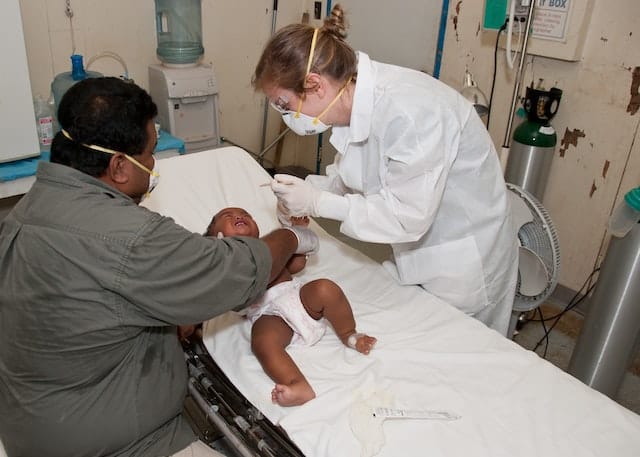Newborns are known for their jerky movements and reflexes, which can be concerning for new parents. One such movement is leg shaking while stretching, which is a common occurrence in newborns. This movement can be mistaken for seizures, causing unnecessary worry for parents.
It is important to understand the difference between normal movements and seizures to ensure the proper care for your newborn.
Understanding newborn leg shaking is crucial for parents to differentiate between normal movements and seizures. The movements can occur during stretching or when the baby is excited or upset. It is important to note that newborns have immature nervous systems, which can lead to jerky movements.
However, if the movements are accompanied by other symptoms, it may be a sign of a more serious condition.
Key Takeaways
- Newborn leg shaking while stretching is a common occurrence.
- Understanding the difference between normal movements and seizures is crucial for parents.
- If leg shaking is accompanied by other symptoms, it may be a sign of a more serious condition.
Understanding Newborn Leg Shaking
Newborns are known for their jerky and uncoordinated movements, and leg shaking is a common occurrence during their development. It is often seen when the baby is stretching or awakening from sleep. This movement is usually involuntary and can be a sign of healthy development.
The shaking of the legs is caused by the immature nervous system of the newborn. The brain and nervous system are still developing, and the coordination of movements is not yet fully developed. The shaking is a normal part of the baby’s development and usually disappears as the baby grows.
Parents should not be alarmed by the leg shaking as it is a common and normal occurrence. However, if the shaking is accompanied by other symptoms such as fever or lethargy, it is important to seek medical attention.
It is also important to note that not all leg shaking is normal. There are certain conditions that can cause involuntary movements in newborns, such as seizures. If the shaking is accompanied by other symptoms such as a change in skin color or breathing difficulties, it is important to seek medical attention immediately.
In summary, newborn leg shaking is a common and normal occurrence during a baby’s development. It is caused by the immature nervous system and usually disappears as the baby grows. However, if the shaking is accompanied by other symptoms, it is important to seek medical attention.
Causes of Leg Shaking
Newborns often exhibit leg shaking while stretching, which can be a cause of concern for new parents. However, in most cases, it is a normal part of their development. Here are some common causes of leg shaking in newborns:
1. Immature Nervous System
Newborns have an immature nervous system, which can cause them to shake or tremble while stretching. This is because their nervous system is still developing, and they have not yet gained full control over their movements.
2. Low Blood Sugar (Hypoglycemia)
Low blood sugar or hypoglycemia can also cause leg shaking in newborns. This is because the brain requires a constant supply of glucose to function properly, and a drop in blood sugar levels can affect the nervous system, leading to shaking or tremors.
3. Caffeine
Caffeine intake by the mother during pregnancy can also cause leg shaking in newborns. Caffeine can pass through the placenta and affect the baby’s nervous system, leading to shaking or tremors.
4. Environment
The environment can also play a role in leg shaking in newborns. Exposure to cold temperatures or being in a drafty room can cause the baby to shake or tremble.
5. Alcohol and Marijuana
Alcohol and marijuana consumption during pregnancy can also cause leg shaking in newborns. These substances can affect the baby’s nervous system, leading to shaking or tremors.
6. Fever
Fever can also cause leg shaking in newborns. When the body temperature rises, the nervous system can become overstimulated, leading to shaking or tremors.
In conclusion, leg shaking in newborns is a common occurrence and is usually not a cause for concern. However, if the shaking is persistent or accompanied by other symptoms, it is recommended to consult a healthcare provider.
Symptoms and Signs
Newborns often exhibit various movements and behaviors that can be concerning for parents. One of these is leg shaking while stretching. Here are some symptoms and signs that parents should look out for:
1. Jitteriness
Jitteriness is a common symptom in newborns, and it is characterized by tremors or shakiness in the arms, legs, and body. It is often seen during the first few days of life and can be triggered by various stimuli, such as noise or movement. Jitteriness is usually benign and resolves on its own within a few weeks.
2. Stiffening
Newborns may also exhibit stiffening of their arms and legs. This may be a sign of a neurological condition, such as cerebral palsy or seizures. However, it can also be a normal reflex in response to certain stimuli, such as a sudden loud noise.
3. Crying
Crying is a common sign that a newborn is uncomfortable or in distress. It may be accompanied by leg shaking while stretching, which can indicate that the baby is trying to relieve some discomfort.
4. Breathing
Newborns may also exhibit irregular breathing patterns, such as pauses in breathing or rapid breathing. These can be signs of respiratory distress or other medical conditions.
5. Startle
Newborns may startle easily in response to sudden stimuli, such as a loud noise or sudden movement. This can cause leg shaking while stretching, as the baby tries to regain their balance.
6. Head Bobbing
Head bobbing is another common behavior in newborns. It is often seen when the baby is tired or trying to stay awake. It can also be a sign of a neurological condition, such as hypotonia or cerebral palsy.
7. Eyes Rolling Up
Newborns may also roll their eyes upward, which can be a sign of a neurological condition or a normal reflex in response to certain stimuli.
8. Grimacing
Grimacing is another common behavior in newborns. It is often seen when the baby is uncomfortable or in pain. It can also be a sign of a medical condition, such as reflux or colic.
Overall, leg shaking while stretching in newborns can be a normal behavior or a sign of a medical condition. Parents should monitor their baby’s movements and behaviors and consult with their pediatrician if they have any concerns.
Differentiating Normal Movements from Seizures
Newborns often display a variety of movements that can be concerning for parents. One of these movements is leg shaking while stretching, which can be mistaken for seizures. It is important to differentiate between normal movements and seizures to avoid unnecessary medical interventions.
Normal movements in newborns are often characterized by jitteriness, myoclonus, and jerking movements. Jitteriness is a mild, rhythmic movement that is usually seen in the hands and feet. Myoclonus is a sudden, brief, and involuntary movement that can occur in any part of the body.
Jerking movements are sudden and repetitive movements that can occur in any part of the body and are often related to the baby’s sleep cycle.
On the other hand, seizures are abnormal electrical discharges in the brain that can cause a variety of symptoms, including jerking movements, stiffness, and loss of consciousness. Seizures in newborns can be caused by a variety of factors, including epilepsy, brain injury, and infections.
To differentiate between normal movements and seizures, parents should look for the following signs:
- Duration: Normal movements are usually brief and stop on their own, while seizures can last for several minutes.
- Consistency: Normal movements are usually consistent and occur in response to specific stimuli, while seizures are often unpredictable and can occur without any obvious trigger.
- Frequency: Normal movements occur frequently throughout the day, while seizures are usually less frequent and more intense.
- Response to stimuli: Normal movements are usually responsive to touch or sound, while seizures are often unresponsive to stimuli.
It is important to note that some benign neonatal sleep myoclonus can also cause leg shaking while stretching, which is a normal variant of myoclonus. However, if parents are concerned about their baby’s movements, they should consult a healthcare professional for further evaluation.
Common Newborn Reflexes
Newborn babies are born with several reflexes that are important for their survival and development. These reflexes are involuntary movements that occur in response to certain stimuli. Here are some of the most common newborn reflexes:
1. Startle Reflex
The startle reflex, also known as the Moro reflex, is a common reflex that occurs in newborns. When a baby is startled by a loud noise or sudden movement, they will typically throw their arms and legs out and then bring them back in. This reflex is thought to be a protective mechanism that helps newborns avoid potential danger.
2. Rooting Reflex
The rooting reflex is another common reflex that occurs in newborns. When a baby’s cheek is stroked or touched, they will turn their head towards the stimulus and open their mouth in preparation for feeding. This reflex helps newborns find their mother’s breast or bottle.
3. Sucking Reflex
The sucking reflex is essential for newborns to feed. When a baby’s lips are touched, they will begin to suck. This reflex helps newborns obtain the necessary nutrients for growth and development.
4. Grasp Reflex
The grasp reflex is another common reflex that occurs in newborns. When an object is placed in a baby’s hand, they will grasp it tightly. This reflex is thought to be a primitive survival mechanism that helps newborns hold onto their mother’s fur or hair.
In conclusion, newborn babies have several reflexes that are important for their survival and development. These reflexes are involuntary movements that occur in response to certain stimuli, and they help newborns avoid potential danger and obtain the necessary nutrients for growth and development.
Diagnosis and Testing
If a parent notices their newborn’s legs shaking while stretching, it is important to schedule an appointment with their pediatrician. The pediatrician will perform a physical exam and ask questions about the baby’s behavior and medical history.
If the pediatrician suspects a neurological issue, they may recommend an electroencephalogram (EEG) to evaluate the baby’s brain activity. An EEG measures the electrical activity in the brain and can help identify abnormal patterns that may indicate infantile spasms or other neurological conditions.
In some cases, an MRI may also be recommended to evaluate the baby’s brain structure and identify any signs of brain injury, stroke, or other abnormalities.
If the pediatrician suspects a genetic disorder, they may recommend a genetic test to identify any underlying genetic mutations that may be contributing to the leg shaking.
Early recognition and diagnosis of any underlying conditions is important for ensuring appropriate treatment and management.
Treatment Options
If a newborn’s leg shaking while stretching is caused by benign conditions, such as a normal reflex or muscle immaturity, no specific treatment is needed. However, if the shaking is persistent, severe, or accompanied by other symptoms, medical attention may be necessary.
In some cases, gentle massage or stretching exercises may help reduce the shaking and improve muscle tone. Parents can consult with their pediatrician or a physical therapist for guidance on appropriate exercises.
If the shaking is related to a medical condition, such as hypoglycemia or hypocalcemia, treatment of the underlying condition is necessary. In some cases, medication may be prescribed to manage symptoms or improve muscle function.
It is important to note that certain medications or drugs, such as caffeine, can affect a newborn’s muscle function and cause shaking. If a mother is breastfeeding, she should avoid consuming large amounts of caffeine, as it can be transferred to the baby through breast milk.
In rare cases, surgery may be necessary to correct a congenital or neurological condition that is causing the shaking. However, this is typically a last resort and only recommended if all other treatment options have been exhausted.
Overall, treatment options for newborn leg shaking while stretching depend on the underlying cause of the condition and should be determined in consultation with a healthcare professional.
Developmental Milestones and Leg Shaking
As babies grow, they go through various developmental milestones that mark their progress towards becoming more mobile and independent. One of these milestones is leg shaking while stretching. This movement is common among newborns and is a sign of healthy development.
At around 2 to 3 months old, babies start to develop better control over their muscles and movements. They begin to stretch more often, and this is when leg shaking may occur. This movement is a natural reflex that helps babies to exercise and strengthen their leg muscles.
Leg shaking while stretching is often accompanied by other movements, such as kicking, flailing, and rolling over. These actions are all part of a baby’s development and help them to gain more control over their body.
As babies continue to grow and develop, they will reach other milestones such as crawling, standing, and walking. These milestones are all important steps towards independence and are a sign of healthy development.
It is important to note that every baby develops at their own pace and may reach milestones at different times. However, if a baby is not meeting developmental milestones within a reasonable timeframe, it may be a sign of a developmental delay and should be discussed with a healthcare provider.
In summary, leg shaking while stretching is a normal and healthy part of a baby’s development. As babies grow and reach other milestones, they will continue to gain more control over their movements and become more independent.
When to Seek Medical Attention
While newborn leg shaking during stretching is common and usually harmless, there are some situations where parents should seek medical attention.
If the shaking is accompanied by other symptoms such as fever, lethargy, poor feeding, or vomiting, parents should take their baby to the hospital immediately. These symptoms can indicate a more serious underlying condition that requires medical attention.
If the shaking persists for more than a few weeks or seems to be getting worse, parents should consult with a pediatric neurologist. Early diagnosis of neurological disorders can lead to better outcomes for the child, so it is important to seek medical attention as soon as possible.
If the baby seems unwell in any way, parents should not hesitate to seek medical attention. It is always better to be safe than sorry when it comes to the health of a newborn.
In summary, while newborn leg shaking during stretching is usually harmless, parents should be aware of the signs that indicate a need for medical attention. Seeking early diagnosis and treatment can lead to better outcomes for the child, so it is important to be vigilant and consult with a medical professional if there are any concerns.
Conclusion
In summary, newborn leg shaking while stretching is a common phenomenon that occurs in many infants. While it may seem concerning to new parents, it is generally harmless and does not require medical attention.
The shaking of the legs during stretching is a natural reflex that occurs as the baby’s nervous system develops. As the baby’s muscles grow and strengthen, the reflex will gradually disappear.
It is important for parents to observe their baby’s behavior and movements, but they should not be overly concerned about leg shaking during stretching. If there are any other concerning symptoms or behaviors, parents should consult their pediatrician.
Overall, parents can rest assured that newborn leg shaking while stretching is a normal part of development and will typically resolve on its own.
Related Posts:
Frequently Asked Questions

Iesha is a loving mother of 2 beautiful children. She’s an active parent who enjoys indoor and outdoor adventures with her family. Her mission is to share practical and realistic parenting advice to help the parenting community becoming stronger.




